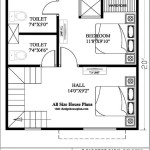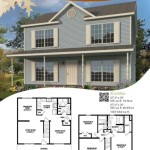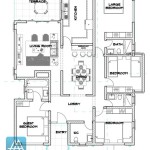Building a House Floor Plan: Free Resources and Considerations
Designing a house floor plan is a crucial step in the home building process. Whether undertaking a new construction project or a significant renovation, a well-conceived floor plan maximizes functionality, aesthetics, and the overall living experience. While professional architectural services offer customized solutions, numerous free resources are available to help individuals create initial floor plan concepts and explore design possibilities. This article will explore these free resources, outlining their capabilities and limitations, and provide key considerations for effective floor plan design.
Access to free floor plan design tools has democratized the initial stages of home design. Previously, homeowners were entirely reliant on architects or drafting professionals to visualize and develop potential layouts. Now, individuals can experiment with various room configurations, furniture arrangements, and spatial relationships before committing to costly professional services. This allows for greater homeowner involvement in the design process, ensuring the final product aligns more closely with their specific needs and preferences.
Leveraging Free Online Floor Plan Software
The internet hosts a diverse selection of free floor plan software applications, ranging from basic 2D drafting tools to more sophisticated 3D modeling platforms. These tools empower users to create digital representations of their desired house layout. While the capabilities and ease of use vary significantly, most free options provide a foundational set of features.
One common advantage of online floor plan software is the user-friendly interface. Many programs employ a drag-and-drop system, enabling users to easily add walls, doors, windows, and furniture elements to their virtual floor plan. Pre-loaded furniture and appliance libraries streamline the design process, allowing users to visualize how various pieces will fit within the space. Features such as automatic dimensioning and area calculations provide valuable insights into the scale and proportion of each room and the overall floor plan.
However, free versions often come with limitations. These may include restrictions on the number of projects that can be saved, limited access to advanced features, or the presence of watermarks on exported plans. Users should carefully evaluate the software's capabilities and limitations to ensure it meets their specific design needs. Some software may also require a steep learning curve, as mastering all the tools available may take time. It is also vital to check compatibility with various operating systems and browsers.
Examples of popular free online floor plan software include Planner5D, Floorplaner, and RoomSketcher. Each platform has its own strengths and weaknesses, catering to different user preferences and skill levels. Planner5D offers a user-friendly interface and a wide selection of 3D furniture models, making it suitable for visualizing interior design concepts. Floorplaner provides robust 2D drafting tools along with 3D rendering capabilities, making it a good option for creating detailed and accurate floor plans. RoomSketcher offers both 2D and 3D design options. Users can create floor plans, furnish rooms, and even generate 3D walkthroughs.
Users should always be aware of the security and privacy implications of using online software. Read the terms of service and privacy policies carefully to understand how the platform collects, uses, and protects user data. Select reputable software providers with a strong track record of data security.
Utilizing Graph Paper and Manual Drafting Techniques
Despite the prevalence of digital tools, traditional manual drafting methods remain a viable option for creating house floor plans. Graph paper, pencils, erasers, and rulers are inexpensive and readily available, allowing for a tactile and hands-on approach to design. This method is particularly appealing to individuals who prefer a more artistic and intuitive process.
Manual drafting provides a tangible connection to the design process. Users can physically draw and erase lines, refine shapes, and experiment with different layouts. This can foster a deeper understanding of spatial relationships and design principles. Since the process involves drawing by hand, it can improve focus and visualization skills. However, manual drafting requires a certain level of technical drawing skills and knowledge of architectural conventions.
A key advantage of manual drafting is its independence from technology. No internet connection or software subscription is required. This is particularly useful for individuals who prefer to disconnect from digital devices or who live in areas with limited internet access. Furthermore, manual drafting provides a permanent physical record of the design process. These paper plans can be easily stored, referenced, and shared with others.
One significant limitation of manual drafting is the difficulty of making changes. Erasing and redrawing lines can be time-consuming and may compromise the accuracy of the plan. It is also challenging to create 3D visualizations using manual techniques. However, this can be mitigated by creating multiple drafts and using color-coded pencils to denote different elements of the floor plan.
When using graph paper, select an appropriate scale for the floor plan. A common scale is 1/4 inch equals 1 foot, or 1/8 inch equals 1 foot, depending on the size of the house and the desired level of detail. Use a sharp pencil and a straight edge to draw precise lines. Remember to include all essential elements, such as walls, doors, windows, stairs, and plumbing fixtures. Clearly label each room and indicate dimensions for all spaces. It is beneficial to create a legend to represent different materials and features. Employing different line weights and shading techniques can enhance the readability of the plan.
Key Considerations for Effective Floor Plan Design
Regardless of the method used, several fundamental principles should guide the design of a house floor plan. These considerations encompass functionality, circulation, natural light, spatial relationships, and future adaptability.
Functionality is paramount. The floor plan should facilitate the daily activities and routines of the occupants. Consider the intended use of each room and ensure that the layout supports those activities. For example, the kitchen should be designed for efficient food preparation and storage, while the living room should provide a comfortable space for relaxation and entertainment. The placement of bathrooms should be convenient to bedrooms and living areas, while laundry rooms should be located near bedrooms or utility areas. Good overall design will incorporate functionality seamlessly.
Circulation refers to the flow of movement throughout the house. The floor plan should provide clear and unobstructed pathways between rooms. Avoid creating bottlenecks or convoluted routes that impede movement. Consider the placement of doors and hallways to ensure easy access to all areas of the house. Optimize the layout to allow efficient movement of people and goods, minimizing obstructions and promoting flow. Thoughtful planning of circulation patterns can significantly enhance the livability of the home.
Natural light is an essential element of a well-designed house. The floor plan should maximize the penetration of natural light into all rooms. Consider the orientation of the house and the placement of windows to capture sunlight throughout the day. Large windows and skylights can brighten interior spaces and create a more cheerful and inviting atmosphere. Avoid placing rooms that require ample natural light, such as living rooms and kitchens, in shaded areas. Harnessing natural light not only reduces energy consumption but also enhances the overall well-being of the occupants.
Spatial relationships refer to the proximity and connection between different rooms. The floor plan should create a harmonious relationship between various spaces. Consider the adjacencies of rooms and how they relate to one another. For example, the kitchen should be adjacent to the dining room to facilitate meal service, while the master bedroom should be located away from noisy areas. Create a balance between open and enclosed spaces, offering both privacy and opportunities for social interaction. Thoughtful consideration of spatial relationships can enhance the functionality and convenience of the home.
Future adaptability is another crucial consideration. The floor plan should be designed to accommodate future changes and needs. Consider the possibility of adding rooms, expanding existing spaces, or adapting the house for aging in place. Design flexible spaces that can be easily converted to different uses. For example, a spare bedroom can be used as a home office or a guest room. Ensure that the layout can accommodate future accessibility modifications, such as wider doorways and ramps. Planning for future adaptability can ensure that the house remains functional and comfortable for years to come.
Before committing to a final floor plan, it is beneficial to seek feedback from others. Share the plan with family members, friends, or even online communities dedicated to home design. Consider their suggestions and make revisions as needed. It is also advisable to consult with a building professional to ensure that the floor plan meets building codes and structural requirements.

Free Floor Plan Creator Design 2d 3d Layouts Easily

Free Floor Plan Creator Design 2d 3d Layouts Easily

Draw Floor Plans Try Smartdraw Free And Easily More

Free Floor Plan Creator Design 2d 3d Layouts Easily

4 Bedroom House Free Design 3d Floor Plans By Planner 5d

Floor Plans Solution Conceptdraw Com

Easily Create 2d 3d Floor Plans No Design Skills Required

Get Started Today With Your Free Account Roomsketcher

Looking For House Plans Here S Some Free Simple Two Y Home Blueprints And Floor With Cost To Build

Sims House 1 Free Design 3d Floor Plans By Planner 5d
Related Posts








